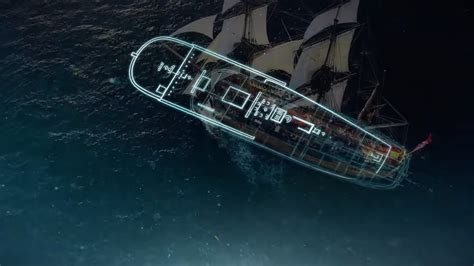
The Rhode Island Marine Archaeology Project (RIMAP) has identified a shipwreck in Newport Harbor as likely being the Endeavour, the famed research vessel commanded by Captain James Cook on his first voyage to the Pacific. This announcement potentially resolves a long-standing mystery surrounding the final resting place of the ship, which played a significant role in maritime history.
For years, maritime archaeologists have debated the location of the Endeavour, known originally as the Earl of Pembroke before being renamed by the British Royal Navy. It was later deliberately sunk in 1778, during the American Revolutionary War, as part of a fleet of ships scuttled to blockade Newport Harbor from the French. Now, after a meticulous investigation and cross-referencing of historical documents, RIMAP believes they have found the answer.
“This is an exciting moment,” said Dr. Kathy Abbass, Executive Director of RIMAP, the organization leading the investigation. While definitive proof requires further analysis, the circumstantial evidence is compelling. The identification is based on a combination of factors, including the ship’s size, construction methods, location within the harbor, and comparison to historical records.
The Endeavour’s historical significance is undeniable. From 1768 to 1771, under the command of Captain Cook, the ship charted the coasts of New Zealand and Australia, contributing significantly to European understanding of the Pacific region. The voyage facilitated scientific observations of the transit of Venus, collected extensive botanical specimens, and established first contact with numerous indigenous populations.
A Tangled Web of Ships
The challenge in identifying the Endeavour has been complicated by the fact that it was one of thirteen transport ships deliberately sunk by British forces in Newport Harbor during the Revolution. These ships, collectively referred to as the “Newport fleet,” were scuttled to prevent French warships from entering the harbor and providing support to the American revolutionaries.
RIMAP has been meticulously mapping and studying the wrecks in Newport Harbor for decades. Their research involves painstakingly piecing together historical records, archaeological data, and scientific analysis to identify each vessel. The Endeavour became a prime target due to its historical prominence.
Evidence and Analysis
The evidence supporting the Endeavour identification is multifaceted. Firstly, historical documents provide detailed information about the ship’s dimensions and construction. Archaeological findings, including timbers and artifacts recovered from the shipwreck site, have been compared to these historical records.
“The construction details of the shipwreck, its size, and the location align with what we know about the Endeavour,” Dr. Abbass explained. Specifically, the ship’s keel length, frame spacing, and timber scantlings closely match the Endeavour’s specifications.
Further evidence comes from the ship’s location within the harbor. Historical maps and accounts pinpoint the area where the Newport fleet was sunk. RIMAP’s sonar surveys and underwater excavations have focused on this area, leading to the discovery of several shipwrecks. The identified Endeavour candidate lies within the expected location, bolstering the identification claim.
Additionally, artifacts recovered from the site offer clues. These include ceramics, glass, and metal objects that are consistent with the ship’s period and function. Analysis of these artifacts can provide information about the ship’s crew, cargo, and activities.
Challenges and Ongoing Research
Despite the compelling evidence, confirming the Endeavour identification remains a complex undertaking. The shipwreck is heavily damaged, and many of its features are obscured by sediment and marine growth. Furthermore, the mixing of artifacts from multiple shipwrecks in the harbor complicates the process.
RIMAP is continuing its research to gather further evidence and strengthen the identification claim. This includes conducting additional underwater excavations, analyzing recovered artifacts, and consulting with experts in naval architecture and maritime history.
One of the key challenges is to obtain definitive proof that links the shipwreck to the Endeavour’s specific history. This could involve finding artifacts with identifiable markings, such as the ship’s name or the Royal Navy’s broad arrow. Another possibility is to conduct dendrochronological analysis of the ship’s timbers, which could reveal the age and origin of the wood.
International Collaboration and Controversy
The Endeavour identification project has involved international collaboration, with experts from Australia, New Zealand, and the United Kingdom contributing their knowledge and expertise. The Australian National Maritime Museum (ANMM) has been a particularly close partner, providing access to its extensive collection of Endeavour artifacts and historical documents.
However, the identification has also been met with some controversy. In 2018, the ANMM issued a statement asserting that it had identified the Endeavour wreck with certainty, based on its own research. RIMAP disputed this claim, arguing that the evidence was not yet conclusive. The disagreement highlighted the complexities of maritime archaeology and the challenges of identifying shipwrecks based on limited data.
While RIMAP acknowledges the ANMM’s contributions, it maintains that its own research provides the strongest evidence to date for the Endeavour identification. The organization emphasizes the importance of rigorous scientific methodology and the need for independent verification of findings.
The Endeavour’s Legacy
Regardless of the remaining uncertainties, the Endeavour remains one of the most significant ships in maritime history. Its voyage to the Pacific had a profound impact on European understanding of the region, leading to the colonization of Australia and the transformation of the Pacific world.
Captain James Cook’s leadership and navigational skills were instrumental to the Endeavour’s success. He was a meticulous surveyor, a skilled navigator, and a respected leader who maintained discipline and order among his crew. Cook’s journals and charts provided invaluable information for future explorers and traders.
The Endeavour also played a crucial role in the advancement of scientific knowledge. The ship carried a team of scientists, including botanist Joseph Banks and naturalist Daniel Solander, who collected thousands of plant and animal specimens. These specimens were brought back to Europe, where they were studied and classified, contributing significantly to the understanding of the natural world.
Preservation and Public Access
If the Endeavour identification is definitively confirmed, it will raise important questions about the preservation and management of the shipwreck site. The wreck is currently protected under state and federal laws, but further measures may be necessary to ensure its long-term preservation.
One option is to create an underwater archaeological park, allowing divers to visit the site and learn about the Endeavour’s history. However, this would need to be carefully managed to prevent damage to the wreck and ensure the safety of divers.
Another option is to raise sections of the shipwreck and display them in a museum. This would provide the public with a close-up view of the ship’s construction and artifacts. However, raising the wreck would be a complex and expensive undertaking, and it could also damage the fragile remains.
Ultimately, the decision on how to preserve and manage the Endeavour shipwreck will need to be made in consultation with stakeholders, including RIMAP, the ANMM, the Rhode Island Historical Preservation & Heritage Commission, and the local community.
The Future of Maritime Archaeology
The Endeavour identification project highlights the importance of maritime archaeology in uncovering and preserving our maritime heritage. Maritime archaeologists use a combination of historical research, archaeological excavation, and scientific analysis to study shipwrecks and other submerged sites.
Their work provides valuable insights into the past, shedding light on maritime trade, naval warfare, and the lives of sailors and passengers. Maritime archaeology also helps to protect these valuable resources from looting, development, and natural decay.
As technology advances, maritime archaeologists are increasingly using sophisticated tools such as sonar, remotely operated vehicles (ROVs), and 3D imaging to explore and document underwater sites. These tools allow them to study shipwrecks in greater detail and with less disruption to the marine environment.
The Endeavour identification project serves as a reminder that the oceans hold a vast store of historical information, waiting to be discovered. By continuing to invest in maritime archaeology, we can unlock the secrets of the past and gain a deeper understanding of our maritime heritage.
Expanded Context and Background Information
To fully appreciate the significance of the Endeavour‘s potential discovery, it’s important to delve deeper into the historical context surrounding the ship and its voyages.
Captain James Cook: A Pioneer of Exploration
Captain James Cook (1728-1779) was a British explorer, navigator, cartographer, and captain in the Royal Navy. He made detailed maps of Newfoundland prior to making three voyages to the Pacific Ocean between 1768 and 1779. He meticulously charted areas from New Zealand to Hawaii in unprecedented detail and on a scale not previously achieved. Cook possessed a unique combination of skills, including seamanship, navigation, leadership, and scientific curiosity. He was also known for his commitment to the welfare of his crew, implementing measures to prevent scurvy and other diseases.
The First Voyage: Scientific Exploration and Territorial Claims
Cook’s first voyage aboard the Endeavour (1768-1771) was ostensibly for scientific purposes: to observe the transit of Venus from Tahiti. However, the voyage also had a secret mission: to search for the mythical “Terra Australis Incognita,” a vast southern continent believed to exist in the South Pacific.
The Endeavour carried a team of scientists, including botanist Joseph Banks, naturalist Daniel Solander, astronomer Charles Green, and artist Sydney Parkinson. They collected thousands of plant and animal specimens, made astronomical observations, and documented the cultures of the Pacific Islanders they encountered.
During the voyage, Cook circumnavigated New Zealand, proving that it consisted of two main islands. He also charted the east coast of Australia, claiming it for Great Britain and naming it New South Wales. Cook’s detailed maps and descriptions of these lands opened the way for British colonization.
The Endeavour’s Later Years: From Research Vessel to Transport Ship
After its historic voyage to the Pacific, the Endeavour was refitted and renamed the Lord Sandwich. It was repurposed as a naval transport ship, carrying troops and supplies during the American Revolutionary War. In 1778, it was deliberately sunk in Newport Harbor, Rhode Island, along with other British ships, to prevent French warships from entering the harbor and aiding the American colonists.
The Significance of Newport Harbor
Newport, Rhode Island, played a significant role during the American Revolution. It was a major port city with a strategic location. The British occupied Newport from 1776 to 1779, using it as a naval base. In 1778, a French fleet arrived off the coast of Newport, seeking to support the American cause. To prevent the French from entering the harbor, the British scuttled thirteen transport ships, including the Endeavour, in the main channel.
The Challenges of Maritime Archaeology in Newport Harbor
The identification of shipwrecks in Newport Harbor is a challenging task due to several factors:
- Multiple Shipwrecks: Thirteen ships were deliberately sunk in the harbor, making it difficult to distinguish one wreck from another.
- Damage and Decay: The shipwrecks have been exposed to the harsh marine environment for over two centuries, leading to significant damage and decay.
- Sedimentation: The shipwrecks are buried under layers of sediment, making it difficult to access and examine them.
- Limited Visibility: Underwater visibility in Newport Harbor is often poor, making it difficult to conduct visual surveys and excavations.
The Role of RIMAP
The Rhode Island Marine Archaeology Project (RIMAP) is a non-profit organization dedicated to studying and preserving Rhode Island’s maritime history. Founded in 1992, RIMAP has been conducting archaeological research in Newport Harbor for over two decades, focusing on the identification of the Newport fleet shipwrecks.
RIMAP’s research methodology involves a combination of historical research, archaeological surveys, and scientific analysis. The organization collaborates with experts from around the world, including historians, archaeologists, naval architects, and dendrochronologists.
The Potential Impact of the Endeavour Discovery
The definitive identification of the Endeavour would have a significant impact on several fronts:
- Historical Significance: It would provide a tangible link to one of the most important voyages of exploration in history.
- Tourism and Education: It would attract tourists and researchers from around the world, boosting the local economy and promoting education about maritime history.
- Archaeological Research: It would provide an opportunity for further archaeological research, shedding new light on the Endeavour‘s construction, crew, and activities.
- Cultural Heritage: It would contribute to the preservation of our shared cultural heritage, ensuring that the Endeavour‘s legacy is remembered for generations to come.
The Ongoing Debate and Future Research
Despite RIMAP’s compelling evidence, the identification of the Endeavour remains a subject of ongoing debate. Some historians and archaeologists remain skeptical, arguing that more definitive proof is needed.
Future research efforts will likely focus on:
- Further Underwater Excavations: Conducting additional excavations at the shipwreck site to uncover more artifacts and structural details.
- Artifact Analysis: Analyzing recovered artifacts to identify markings, provenance, and other clues that could link them to the Endeavour.
- Dendrochronological Analysis: Conducting dendrochronological analysis of the ship’s timbers to determine the age and origin of the wood.
- Comparative Analysis: Comparing the shipwreck’s features and artifacts to those of other 18th-century ships to strengthen the identification claim.
Conclusion
The potential discovery of the Endeavour in Newport Harbor represents a significant milestone in maritime archaeology. While definitive confirmation requires further research, the evidence gathered by RIMAP to date is compelling. The Endeavour played a pivotal role in shaping our understanding of the world, and its rediscovery would provide a unique opportunity to learn more about its history and legacy. The ongoing research and analysis will undoubtedly continue to captivate historians, archaeologists, and the public alike, as we strive to unravel the mysteries of the past and preserve our shared maritime heritage.
Frequently Asked Questions (FAQ)
1. What is the significance of the Endeavour?
The Endeavour, originally named Earl of Pembroke, was a British Royal Navy research vessel commanded by Captain James Cook on his first voyage of discovery to the Pacific Ocean from 1768 to 1771. During this voyage, Cook charted the coasts of New Zealand and Australia, making significant contributions to European knowledge of the region. The ship was also instrumental in scientific observations, botanical collections, and establishing contact with indigenous populations. Its role in exploration, scientific advancement, and territorial claims makes it a vessel of paramount historical importance.
2. Where was the Endeavour found?
The shipwreck believed to be the Endeavour was located in Newport Harbor, Rhode Island. It is one of thirteen transport ships deliberately sunk by the British in 1778 during the American Revolutionary War to prevent French warships from entering the harbor and supporting the American colonists.
3. What evidence supports the claim that the wreck is the Endeavour?
The Rhode Island Marine Archaeology Project (RIMAP) has presented several lines of evidence supporting the identification. This includes the ship’s size and construction details, which align with historical records of the Endeavour. The location of the wreck within Newport Harbor is consistent with historical maps and accounts of where the British fleet was scuttled. Artifacts recovered from the site also date back to the appropriate period. Specifically, the construction details of the shipwreck, its size, and the location align with what we know about the Endeavour,” Dr. Abbass explained. Specifically, the ship’s keel length, frame spacing, and timber scantlings closely match the Endeavour’s specifications.
4. Why has it taken so long to identify the Endeavour wreck?
Identifying the Endeavour has been a complex and lengthy process due to several factors. The Newport Harbor contains the wrecks of thirteen ships, making it difficult to distinguish one from another. The wrecks have been exposed to the marine environment for over two centuries, resulting in significant damage and decay. Sedimentation and poor underwater visibility also complicate the process of surveying and excavating the sites. Furthermore, the Endeavour was originally named Earl of Pembroke, adding another layer of complexity to the historical tracking.
5. What are the next steps in confirming the Endeavour identification?
While the evidence is compelling, further research is needed to definitively confirm the identification. This includes conducting additional underwater excavations to uncover more artifacts and structural details. Analyzing recovered artifacts to identify markings, provenance, and other clues that could link them to the Endeavour. Conducting dendrochronological analysis of the ship’s timbers to determine the age and origin of the wood. Comparative analysis of the shipwreck’s features and artifacts to those of other 18th-century ships is also important. This rigorous process aims to provide conclusive proof that the wreck is indeed the Endeavour.









